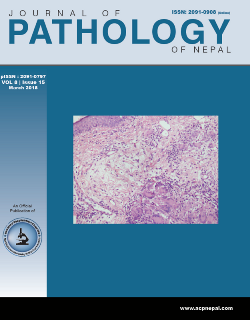A study of gastrointestinal tumors at kathmandu medical college teaching hospital
DOI:
https://doi.org/10.3126/jpn.v8i1.19455Keywords:
Benign, Colorectal, Malignant, Polyp, TumourAbstract
Background: Gastrointestinal tract tumour is responsible for more cancers and death than any other cancers. The tumour in GIT include the tumour of the Oral cavity, Esophagus, Stomach, Colon, Rectum, Liver, Gallbladder, Pancreas and Biliary tree.
Materials and methods: A cross sectional study was carried out among all the gastrointestinal tract tumours specimens received for histopathological examination in between January 2016 to June 2017 in Department of Pathology, Kathmandu Medical College Teaching Hospital. All tumors diagnosed either benign or malignant were included in this study. Ethical clearance was obtained from the Institutional Review Committee in KMCTH.
Results: Colorectum was found to be the most commonly involved site for malignant lesion comprising 40.2% among all malignant lesions followed by stomach comprising 28.6%. Malignancy was found to be more prevalent among male with M:F ratio of 1.6:1 in colorectal region and 1.4:1 in stomach cancers. Regarding benign lesions (polyps), rectum was found to be the commonest site (57.5%), followed by colon (20.0%) and stomach, the least common site.
Malignant lesions were more common among the age group of 51-60 years (37.66%) with 70.13% above 50 years. Benign lesions were also found to be the most common above 50 years comprising 40.0 percent.
Conclusion: Rectum & colon was found to be the most commonly involved site for both malignant and benign lesion. Malignancy is more prevalent among male and common above 50 years of age. However, malignant cases noted in the adult age group are a matter of great concern.
Downloads
Downloads
Published
How to Cite
Issue
Section
License
This license enables reusers to distribute, remix, adapt, and build upon the material in any medium or format, so long as attribution is given to the creator. The license allows for commercial use.




